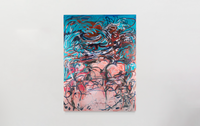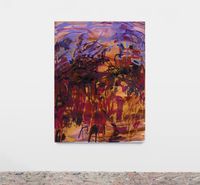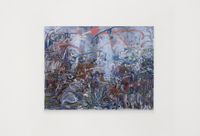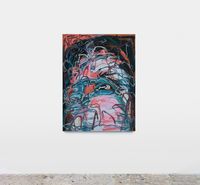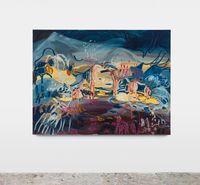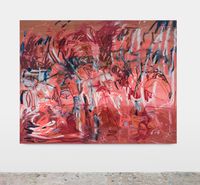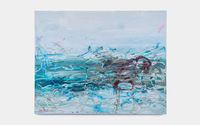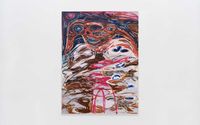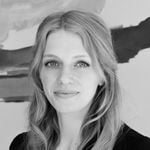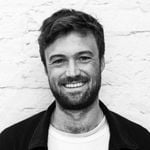Janaina Tschäpe is an established German-Brazilian multi-disciplinary contemporary artist based in New York. Her paintings, drawings, photographs, sculptures, and video works centre on abstract forms evocative of organic life and the natural world, with a strong leaning towards aquatic life.
Read MoreBorn in Munich and raised in São Paolo, Janaina Tschäpe studied fine arts at Hochschule für bildende Künste, Hamburg, graduating in 1997. She then moved to New York, where she completed an MFA at the School of Visual Arts in 1998. Spanning over 20 years and multiple mediums, Janaina Tschäpe's practice revolves around incorporating motifs of plant, aquatic, and human life in ambiguous illusory dream-like environments.
Janaina Tschäpe's artworks collectively explore ideas of myth, perception, morphology and metamorphosis. In her paintings and drawings, Janaina Tschäpe's biomorphic shapes and particular gestural marks convey an emotive sense of a moving and living natural world populated by abstract, organic forms. Each work is colourful, luminous, and deeply layered with details, which the artist meticulously applies in watercolour, casein, coloured pencil, and pastel, among other media.
Through these two-dimensional works in which luscious organic forms coexist with precise markings that overlay and unify the composition, the artist conveys internally felt sensations in an abstract language. In works like Forest (2009) and Swamp Eating the Moon (2018) the sensations are of time and place—the feeling of seeing the light through the trees of a bustling forest or a full moon peering through the thick flora of a darkened swamp.
In Mina Sleeping (2006), on the other hand, the sensation Janaina Tschäpe conveys is the personal emotional sensation of seeing Mina—the daughter she shares with fellow artist Vik Muniz—asleep. Tschäpe explained to Ocula Advisory 'Painting is a life-long endeavour; each canvas is a continuation of an intimate dialogue.'
Janaina Tschäpe's sculptures primarily consist of abstract, organic forms reminiscent of aquatic life like sea urchins and coral, rendered in plastic, bronze, and plasticine. Tschäpe also creates wall-based 'cut-out' works such as Cut Out Lobby (2017), in which bent plywood with hand-brushed paint creates swirling compositions that look like the remains of paper cut-outs.
Janaina Tschäpe's photography and video works demonstrably blur the line between illusion in reality. She often presents images of people, costumes, and sculptures, ambiguously melded to generate seemingly impossible forms. Human form becomes one with an array of billowy fabrics, water-filled latex, plastic balls, and tubing, amongst other objects.
Place is an important element for Tschäpe. The sea particularly holds significance in her work, as her first name derives from the sea goddess of the Afro-Brazilian Candomblé religion. In Janaina Tschäpe's 'Blood, Sea' (2004) series mermaid-like figures moves through water. The video installation by the same name adds life to these surreal aquatic forms through motion and sound.
Other photographs and video works by Tschäpe serve more as documentation of places she has visited. Janaina Tschäpe's '100 Little Deaths' (1996–2002) is a darkly humorous photographic series in which the artist shows herself in different environments lying face down. These images of death allude to the death of her life in that place and the little part of herself the artist left behind as she left.
Janaina Tschäpe artworks have been exhibited in institutional and gallery shows, and art events across the globe. They can be found in major public collections including Centre Pompidou, Paris; Museo Nacional Centro de Arte Reina Sofía, Madrid; National Gallery of Art, Washington, D.C.; and the Solomon R. Guggenheim Museum, New York. Tschäpe has also worked on murals and installations for public spaces in New York, Miami Beach, São Paulo, and Holbæk.
Contemporary counterpoint, Musée de l'Orangerie, Paris (2020); Floating Worlds, Museum of Contemporary Art Tucson (2014); Janaina Tschäpe, Kasama Nichido Museum of Art, Japan (2009); Melantropics, Contemporary Art Museum St. Louis, Missouri (2006); Blood Sea, USF Contemporary Art Museum, Tampa (2004); Sala de Espera, Museo Nacional Centro de Arte Reina Sofía, Madrid (2001).
Life During Wartime: Art in the Age of Coronavirus, USF Contemporary Art Museum, Tampa (2020); Live Dangerously, National Museum of Women in the Arts, Washington, D.C. (2019); Oceans: Imagining a Tidalectic Worldview, Museum of Modern Art Dubrovnik, Croatia (2018); Haunted: Contemporary Photography, Video, and Performance, Guggenheim Museum Bilbao (2010); Fairy Tale–Contemporary Art and Enchantment, Leeds Art Gallery (2007).
Michael Irwin | Ocula
